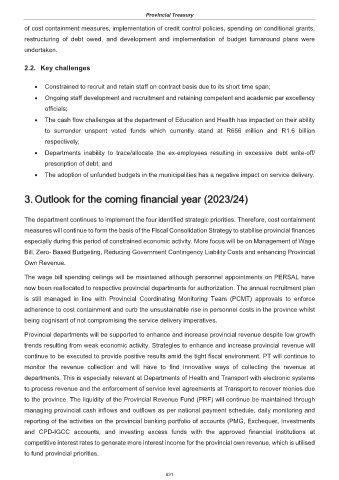Page 648 - Provincial Treasury Estimates.pdf
P. 648
Provincial Treasury
of cost containment measures, implementation of credit control policies, spending on conditional grants,
restructuring of debt owed, and development and implementation of budget turnaround plans were
undertaken.
2.2. Key challenges
x Constrained to recruit and retain staff on contract basis due to its short time span;
x Ongoing staff development and recruitment and retaining competent and academic par excellency
officials;
x The cash flow challenges at the department of Education and Health has impacted on their ability
to surrender unspent voted funds which currently stand at R656 million and R1.6 billion
respectively;
x Departments inability to trace/allocate the ex-employees resulting in excessive debt write-off/
prescription of debt; and
x The adoption of unfunded budgets in the municipalities has a negative impact on service delivery.
3. 3. Outlook for the coming financial year (2023/24)
The department continues to implement the four identified strategic priorities. Therefore, cost containment
measures will continue to form the basis of the Fiscal Consolidation Strategy to stabilise provincial finances
especially during this period of constrained economic activity. More focus will be on Management of Wage
Bill, Zero- Based Budgeting, Reducing Government Contingency Liability Costs and enhancing Provincial
Own Revenue.
The wage bill spending ceilings will be maintained although personnel appointments on PERSAL have
now been reallocated to respective provincial departments for authorization. The annual recruitment plan
is still managed in line with Provincial Coordinating Monitoring Team (PCMT) approvals to enforce
adherence to cost containment and curb the unsustainable rise in personnel costs in the province whilst
being cognisant of not compromising the service delivery imperatives.
Provincial departments will be supported to enhance and increase provincial revenue despite low growth
trends resulting from weak economic activity. Strategies to enhance and increase provincial revenue will
continue to be executed to provide positive results amid the tight fiscal environment. PT will continue to
monitor the revenue collection and will have to find innovative ways of collecting the revenue at
departments. This is especially relevant at Departments of Health and Transport with electronic systems
to process revenue and the enforcement of service level agreements at Transport to recover monies due
to the province. The liquidity of the Provincial Revenue Fund (PRF) will continue be maintained through
managing provincial cash inflows and outflows as per national payment schedule, daily monitoring and
reporting of the activities on the provincial banking portfolio of accounts (PMG, Exchequer, Investments
and CPD-IGCC accounts, and investing excess funds with the approved financial institutions at
competitive interest rates to generate more interest income for the provincial own revenue, which is utilised
to fund provincial priorities.
631

